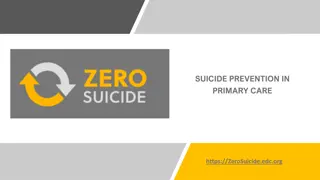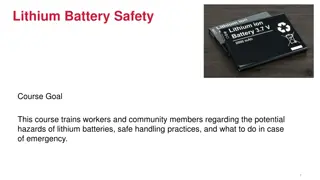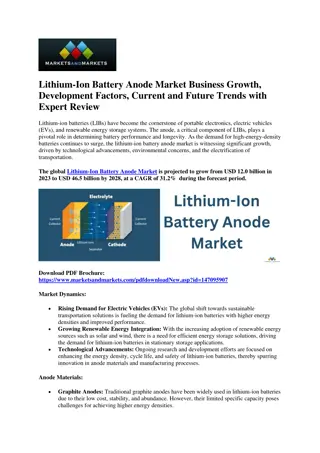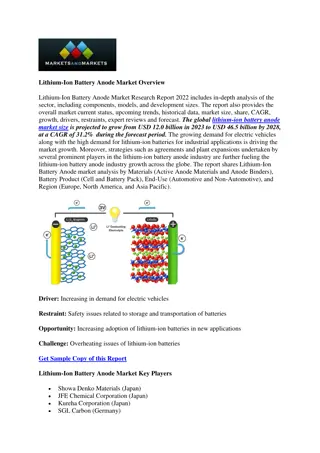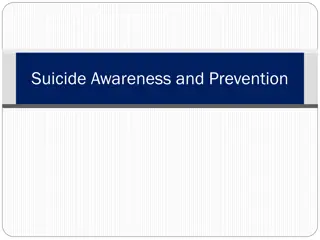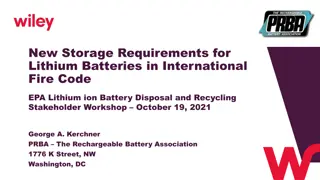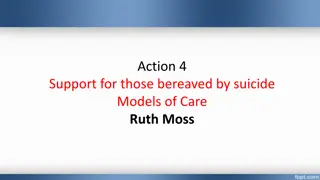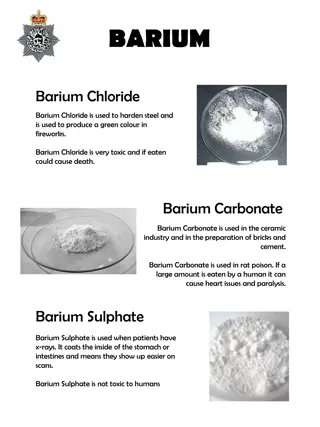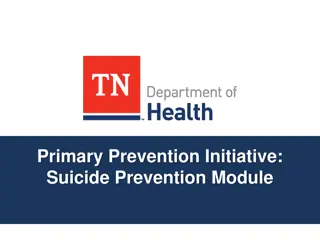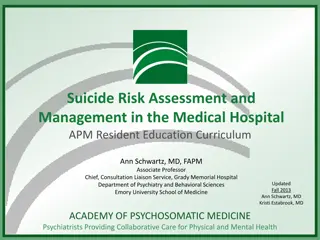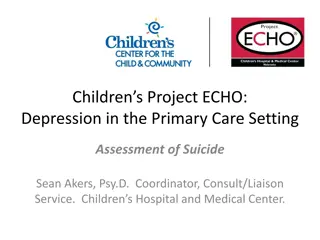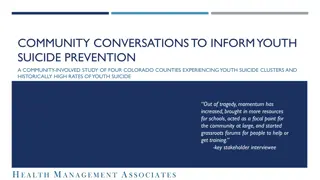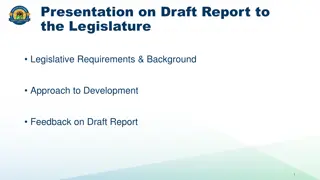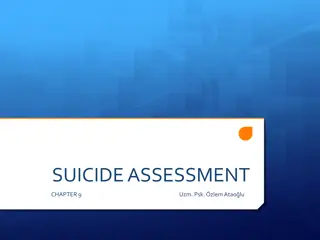Understanding the Connection Between Lithium and Suicide Rates
Examining the correlation between lithium levels and suicide rates reveals mixed findings, with some studies suggesting a potential association while others show weak statistical significance. Factors such as gender, statistical methods, and concentration thresholds further complicate the relationship. Additionally, gaps in research indicate that suicide may not solely have a biologic origin but could also be influenced by environmental and social determinants.
Download Presentation

Please find below an Image/Link to download the presentation.
The content on the website is provided AS IS for your information and personal use only. It may not be sold, licensed, or shared on other websites without obtaining consent from the author. Download presentation by click this link. If you encounter any issues during the download, it is possible that the publisher has removed the file from their server.
E N D
Presentation Transcript
The Geography of The Geography of Lithium and its association to suicide and its association to suicide mortality mortality Lithium GREG COOK GREG@GREGRCOOK.COM SOFTWARE DEVELOPER MADISON, WI PENN STATE MGIS CANDIDATE 8 YEARS IN COUNTY HUMAN SERVICES DEPARTMENT SUPPORT ROLES
Lithium Behavioral Health Biologic Impacts MGIS Capstone Suicide Environment
Key Questions How does lithium interact with the suicide rate? Are soil level lithium concentrations an alternative dataset to water sampling? Can existing studies of lithium and the suicide rate be replicated using soil level lithium concentrations? Does lithium still have an impact on the suicide rate after accounting for social determinants of suicide? Can we develop a consistent metric of societal and economic influences to account for when studying the associated between lithium and the suicide rate?
Summary of Specific Literature Bl ml et al., 2013 Texas counties from 1999 2007 with 3,123 samples from public wells. 2.8 to 219ug/L sample values. Adjusts for median household income, unemployment, population density, percent Hispanic, percent African American. Palmer et al., 2019 15 selected Alabama counties in 2018 with 75 samples from public spaces. 0.4 to 32.9 ug/L sample values. Adjusts for age, gender and poverty. Shiotsuki et al., 2016 Hokkaido and Kysushu Islands in Japan from 2010 to 2015. This represents the northernmost and southernmost regions of Japan. Only adjusts for environmental determinants of suicide; e.g. rainfall, snowfall, temperature, etc. Kabacs et al., 2011 Six counties comprising the East of England region. One sample per the 47 municipal subdivisions in the East of England region. 0.1 ug/L to 21ug/L sample values. Did not find an association between the suicide rate and lithium distribution.
Findings from the Literature Association between a decrease in the suicide rate and increased lithium levels in water sources. The statistical association is weak. Bl ml et al. notes that the association is weak and can be impacted by the statistical methods used for analysis. Significant discussion on how to improve statistical robustness compared to prior work. Inconsistent results based on sex and gender. Few studies have found a relationship between lithium levels and the suicide rates for women. No consistent definition of what is a significant level of lithium. Greater levels seem to correspond with decreased suicide rate. There may be a concentration threshold for the suicide prevention effect of lithium. (Palmer et al.)
Gaps with the Literature Suicide may not be due to a biologic cause. Environmental determinants and social determinants of suicide are both inconsistently addressed. Existing literation that addresses social determinants of suicide still shows a connection between lithium and the suicide rate, but it is significantly weaker and depends on the statistical analysis performed. Assumes consumption source for residents comes from nearest water source. E.g. Many studies focus on public water sources. Individuals in the region could have a well or only drink bottled water.
Cutting to the Chase: Which Project? County scale Limited similar work National County scale Limited similar work Broad transect of the US. Significant variations in wealth, health care and urban / rural divide. E.g. Mississippi River Transect Replicate previous study County and sub county scale Texas Alabama
The Geography of Lithium Driven by: Geology Felsic rocks (e.g. granite and rhyolite) Glaciation Soil Horizon Limited mobility in soil, but higher levels in C horizon due to leaching into clay. 24 mg/kg average in soil C horizon data (David B. Smith, "Geochemical and Mineralogical Maps, with Interpretation, for Soils of the Conterminous United States")
Lithium and Behavioral Health Used as a medication to treat bipolar disorder and major depression that proves resistant to other treatment. ("Lithium Monograph for Professionals") First used as a treatment for bipolar disorder in 1949 by John Cade. (Cade, 1949) Known anti-suicidal effect. (Lewitzka, et al., 2015) Lithium Carbonate (CLi2O3 or Li2CO3) is the compound used for treatment. ("Lithium carbonate") Therapeutic lithium levels are much higher than environmental levels. ~300mg to 900mg daily, target 1.0 to 1.5 mEq/L serum level in blood, toxic above 2.0 mEq/L ("Eskalith Prescribing Information") 150mg is lowest reported effective therapeutic dose. (Parker et al., 2018)
The Geography of Suicide General increase since 1999. Higher for men than women. Highest for women 45 64 and men 75+. Much higher in rural versus urban areas. Native American reservations. Continuing to increase, particularly in specific age and racial groups. ("Americas suicide rate has increased for 13 years in a row")
Trends in Suicide ( Racial and Ethnic Disparities ) ("Increase in Suicide Mortality in the United States, 1999 2018", 2020)
Trends in Suicide cont. ("Increase in Suicide Mortality in the United States, 1999 2018", 2020)
Possible Data Sources Suicide & Behavioral Health CDC Places Large variety of datasets available at multiple scales, including county and Census Tract. E.g. Poor Mental Health Days, county level. SAMSHA Substate data Aggregated to Health service areas which are inconsistent in geographical scale. CDC 500 Cities Project City specific down to Census Tract scale. Considerations Existing research has been completed at the county scale. Census Tracts may be too large of a scale compared to available lithium data sources.
Possible Data Sources - Soil Lithium Levels USGS Report 2017-5118 Usable for county level analysis. Multiple soil horizons were sampled (0 to 5cm, A and C), so which should be used? (David B. Smith, "Geochemical and Mineralogical Maps, with Interpretation, for Soils of the Conterminous United States") National Geochemical Database More granular dataset. Usable for county level or census tract analysis depending on area. No record of what soil horizon the sample was extracted from. Inconsistent sampling equipment not always sensitive enough to detect small concentrations of Lithium. Florida, South Carolina, Missouri, Iowa and North Dakota have good coverage. ( National Geochemical Database: Soil )
Problems with Data Sources Potential support for using soil levels as a stand in for water levels, but not strong. Cannon, W. F., Woodruff, L. G., & Pimley, S. (2003, August 23). Some statistical relationships between stream sediment and soil geochemistry in northwestern Wisconsin-can stream sediment compositions be used to predict compositions of soils in glaciated terranes? Retrieved from https://www.sciencedirect.com/science/article/abs/pii/S0375674203002115 Lithium absorption appears to be primarily through consumption and not through skin or environmental exposure. This study showed that there was no absorption of lithium ion from bathing water at concentrations of 40 5 mg 1-1 (ppm). (McCarty et al., 1994) Lithium and Behavioral Health data sources are maintained at different geographic levels. This will likely require maintaining any data for study at an aggregated level, such as the county.
Cutting to the Chase: Which Project? County scale Limited similar work National County scale Limited similar work Broad transect of the US. Significant variations in wealth, health care and urban / rural divide. E.g. Mississippi River Transect Replicate previous study County and sub county scale Texas Alabama
Questions / Comments? GREG COOK GREG@GREGRCOOK.COM
References Americas suicide rate has increased for 13 years in a row. (n.d.). Retrieved from https://www.economist.com/graphic-detail/2020/01/30/americas-suicide-rate-has-increased-for-13-years-in-a-row Barjasteh-Askari, F., Davoudi, M., Amini, H., Ghorbani, M., Yaseri, M., Yunesian, M., Mahvi, A. H., & Lester, D. (2020). Relationship between suicide mortality and lithium in drinking water: A systematic review and meta- analysis. Journal of Affective Disorders, 264, 234 241. https://doi.org/10.1016/j.jad.2019.12.027 Bl ml, V., Regier, M. D., Hlavin, G., Rockett, I. R. H., K nig, F., Vyssoki, B., Bschor, T., & Kapusta, N. D. (2013). Lithium in the public water supply and suicide mortality in Texas. Journal of Psychiatric Research, 47(3), 407 411. Cade, J. F. (1949). Lithium Salts In The Treatment Of Psychotic Excitement. Medical Journal of Australia, 2(10), 349-352. doi:10.5694/j.1326-5377.1949.tb36912.x David B. Smith, F. S. (n.d.). Geochemical and Mineralogical Maps, with Interpretation, for Soils of the Conterminous United States. Retrieved from https://pubs.usgs.gov/sir/2017/5118/index.html Eskalith Prescribing Information. (n.d.). Retrieved from https://www.accessdata.fda.gov/drugsatfda_docs/label/2004/16860slr074,18152slr020_eskalith_lbl.pdf Falkai, P., Schmitt, A., & Andreasen, N. (2018). Forty years of structural brain imaging in mental disorders: Is it clinically useful or not? Dialogues in Clinical Neuroscience, 20(3), 179 186. Increase in Suicide Mortality in the United States, 1999 2018. (2020, April 08). Retrieved from https://www.cdc.gov/nchs/products/databriefs/db362.htm Kabacs, N., Memon, A., Obinwa, T., Stochl, J., & Perez, J. (2011). Lithium in drinking water and suicide rates across the East of England. British Journal of Psychiatry, 198(5), 406 407. https://doi.org/10.1192/bjp.bp.110.088617 Lewitzka, U., Severus, E., Bauer, R., Ritter, P., M ller-Oerlinghausen, B., & Bauer, M. (2015, July 18). The suicide prevention effect of lithium: More than 20 years of evidence-a narrative review. Retrieved from https://journalbipolardisorders.springeropen.com/articles/10.1186/s40345-015-0032-2 Lithium carbonate. (n.d.). Retrieved from https://pubchem.ncbi.nlm.nih.gov/compound/Lithium-carbonate Lithium Monograph for Professionals. (n.d.). Retrieved from https://www.drugs.com/monograph/lithium.html National Geochemical Database: Soil. (n.d.). Retrieved from https://mrdata.usgs.gov/ngdb/soil/ Making Health Care Better - whitehouse.gov. (n.d.). Retrieved from https://obamawhitehouse.archives.gov/sites/default/files/docs/mental_health_report_final.pdf McCarty, J. D., Carter, S. P., Fletcher, M. J., & Reape, M. J. (1994). Study of lithium absorption by users of spas treated with lithium ion. Human & Experimental Toxicology, 13(5), 315 319. https://doi.org/10.1177/096032719401300506 Palmer, A., Cates, M. E., & Gorman, G. (2019). The Association Between Lithium in Drinking Water and Incidence of Suicide Across 15 Alabama Counties. Crisis, 40(2), 93 99. https://doi.org/10.1027/0227-5910/a000535 Parker, W. F., Gorges, R. J., Gao, Y. N., Zhang, Y., Hur, K., & Gibbons, R. D. (2018). Association Between Groundwater Lithium and the Diagnosis of Bipolar Disorder and Dementia in the United States. JAMA Psychiatry, 75(7), 751 754. https://doi.org/10.1001/jamapsychiatry.2018.1020 Racial and Ethnic Disparities. (n.d.). Retrieved from https://sprc.org/scope/racial-ethnic-disparities Shiotsuki, I., Terao, T., Ishii, N., Takeuchi, S., Kuroda, Y., Kohno, K., Mizokami, Y., Hatano, K., Tanabe, S., Kanehisa, M., Iwata, N., & Matusda, S. (2016). Trace lithium is inversely associated with male suicide after adjustment of climatic factors. The Mental Health Parity and Addiction Equity Act (MHPAEA). (n.d.). Retrieved from https://www.cms.gov/CCIIO/Programs-and-Initiatives/Other-Insurance-Protections/mhpaea_factsheet Vita, A., De Peri, L., & Sacchetti, E. (2015). Lithium in drinking water and suicide prevention: A review of the evidence. International Clinical Psychopharmacology, 30(1), 1 5. https://doi.org/10.1097/YIC.0000000000000048
Behavioral Health Behavioral Health covers Mental Health and Substance Abuse services. A mental health crisis, in general, will have one or more instigating events. Stressor Job loss, Divorce Traumatic Abuse, PTSD Biologic Schizophrenia, Adrenal disorders Active research into biomarkers to identify biologic sources of mental illness and to develop targeted treatments. (Falkai et al., 2018) Some cross categories or may have multiple sources. Major depression, Bipolar disorder Treatment is still largely the same across the source of the crisis.
Access to Behavioral Health services The Mental Health Parity and Addiction Equity Act of 2008 (MHPAEA) expanded biologic parity. Requires health insurance to provide coverage for mental health concerns with a biologic origin. ( The Mental Health Parity and Addiction Equity Act (MHPAEA) ) Still difficult for many to receive services. The Affordable Care Act expanded coverage. ( Making Mental Health Care Better )
Unresolved Questions Does Lithium change on a human time scale? How do we account for socio-economic variables compared to environmental variables when studying the suicide rate? Is soil geochemistry and water geochemistry for lithium comparable? Is there a reason why lithium used for treatment purposes is a compound? (CLi2O3 or Li2CO3)


